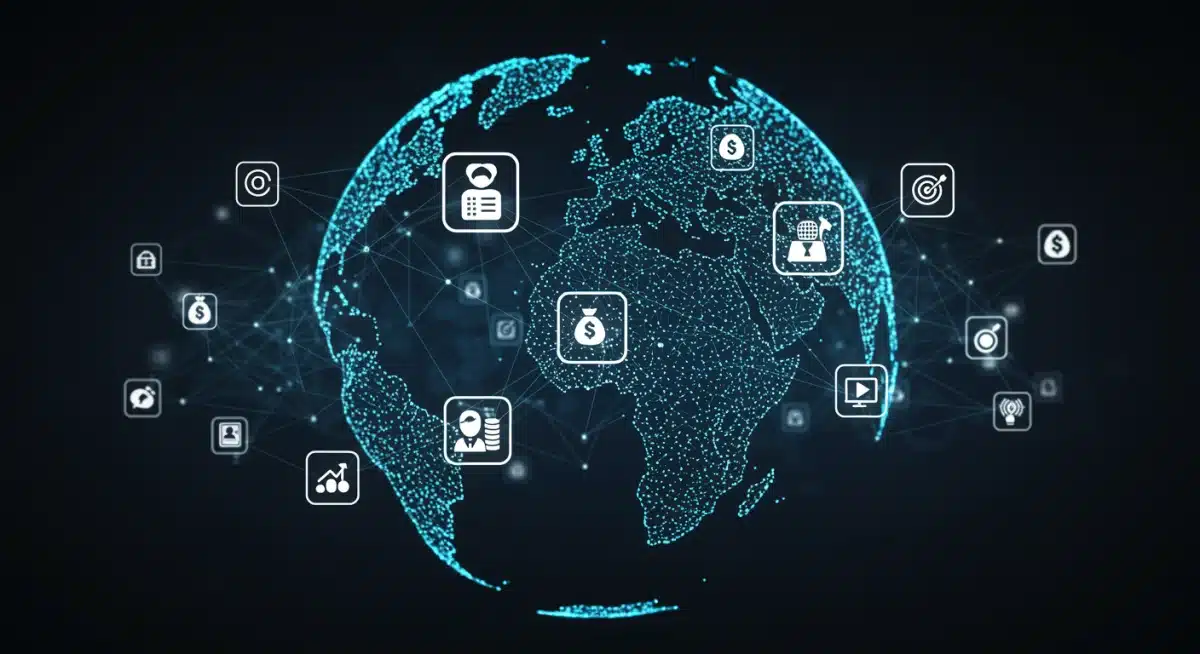Digital Literacy: Bridging the Economic Divide in the US

The role of digital literacy in bridging the economic divide is a critical topic in the United States, impacting access to education, employment, and essential services for millions of citizens.
The Role of Digital Literacy in Bridging the Economic Divide is increasingly central to national discussions, with new reports highlighting its profound impact on individuals and communities across the United States. This issue, once considered secondary, now stands as a primary driver of economic inclusion and social equity, demanding immediate attention and strategic action. Understanding its scope, implications, and potential solutions is more important than ever.
Understanding the Digital Divide in the United States
The digital divide, characterized by the unequal access to and proficiency in digital technologies, continues to be a significant barrier to economic mobility in the U.S. This disparity is not merely about internet access but encompasses the skills needed to effectively navigate the digital landscape. As more aspects of daily life move online, from job applications to healthcare services, those without digital literacy face increasing disadvantages.
Recent data indicates that millions of Americans still lack reliable internet access or the basic skills required to use digital tools efficiently. This gap disproportionately affects low-income households, rural communities, older adults, and certain minority groups, deepening existing socio-economic inequalities. The implications extend far beyond personal inconvenience, impacting educational attainment, workforce participation, and overall quality of life.
Geographic and Socio-economic Disparities
The digital divide manifests differently across various demographics and regions. Urban areas often have better infrastructure, but even there, affordability can be a major hurdle. In contrast, rural areas frequently struggle with both infrastructure limitations and a lack of resources for digital skill development.
- Rural Communities: Limited broadband infrastructure and higher costs often leave these areas underserved.
- Low-Income Households: Financial constraints prevent access to devices, internet services, and training programs.
- Older Adults: Often face challenges in adapting to new technologies without adequate support and training.
- Minority Groups: Systemic inequalities can exacerbate existing digital disparities, limiting opportunities.
Addressing these disparities requires a multi-faceted approach that considers both access to technology and the development of essential digital skills. Without foundational digital literacy, even universal internet access may not fully bridge the economic gap.
The Economic Imperative of Digital Literacy
Digital literacy is no longer a luxury but a fundamental requirement for economic participation and growth. In an increasingly digital economy, individuals equipped with digital skills are better positioned to secure employment, pursue higher education, and access critical financial and health resources. Conversely, those lacking these skills are often relegated to lower-paying jobs with limited advancement opportunities, perpetuating cycles of poverty.
Businesses, too, suffer when a significant portion of the workforce lacks digital proficiency. Productivity can stagnate, innovation may slow, and the overall competitiveness of the economy can diminish. Investing in digital literacy programs is therefore not just a social imperative but a strategic economic one, fostering a more skilled workforce and driving innovation.
Impact on Employment and Career Advancement
The modern job market demands digital fluency across nearly all sectors. From basic computer operations to specialized software applications, employers increasingly seek candidates with demonstrable digital skills. Individuals who can effectively use word processors, spreadsheets, email, and navigate online platforms have a clear advantage.
- Job Search and Application: Most job applications are now exclusively online, requiring digital navigation skills.
- Workplace Productivity: Digital tools are integral to daily tasks, communication, and data management in almost every industry.
- Skill Development: Online learning platforms offer opportunities for upskilling and reskilling, crucial for career progression, but require digital access and literacy.
Without these fundamental abilities, individuals are essentially locked out of vast segments of the labor market, deepening the economic divide. Providing comprehensive digital literacy training is essential to unlock new career paths and ensure a dynamic, adaptable workforce.
Educational Pathways and Digital Inclusion
Education plays a pivotal role in fostering digital literacy from an early age, ensuring that future generations are prepared for a technologically driven world. However, disparities in educational resources mean that not all students receive equitable access to digital tools and instruction. This creates a foundational gap that can be difficult to overcome later in life, reinforcing existing economic inequalities.
Beyond traditional schooling, community-based programs and public libraries are emerging as vital hubs for digital inclusion. These institutions provide free or low-cost access to computers, internet, and guided training, serving as crucial lifelines for adults and families seeking to improve their digital skills. Their role in bridging the economic divide cannot be overstated.

Initiatives Promoting Digital Education
Various initiatives are underway to enhance digital education, ranging from federal funding for broadband expansion to local non-profit programs. These efforts aim to provide not just access, but also the pedagogical support necessary for individuals to become truly digitally literate.
For example, the Affordable Connectivity Program (ACP) has helped millions of low-income households afford internet service, as reported by the Federal Communications Commission (FCC). However, access alone is insufficient; concurrent efforts in digital skill-building are equally vital. Schools are integrating digital citizenship into curricula, while adult education centers offer practical workshops on everything from online safety to advanced software use.
These initiatives are critical for building a society where everyone has the opportunity to thrive in the digital age, regardless of their socio-economic background. The ongoing challenge lies in scaling these programs to reach all who need them.
Government Policies and Private Sector Contributions
Effective government policies are essential to create an enabling environment for digital literacy and inclusion. This involves strategic investments in infrastructure, regulatory frameworks that promote affordability, and funding for educational programs. Federal, state, and local governments are increasingly recognizing the urgency of these issues and allocating resources accordingly.
The private sector also has a crucial role to play. Technology companies, internet service providers, and corporations can contribute through philanthropic efforts, corporate social responsibility initiatives, and by developing accessible and user-friendly digital tools. Partnerships between government, non-profits, and businesses are proving to be the most effective strategy for sustainable change.
Collaborative Approaches to Digital Inclusion
Collaboration is key to tackling the multifaceted challenges of the digital divide. Public-private partnerships leverage the strengths of each sector to deliver more comprehensive and impactful solutions.
- Government Funding: Programs like the Broadband Equity, Access, and Deployment (BEAD) Program allocate billions to expand internet access.
- Corporate Philanthropy: Tech giants often fund digital literacy training programs and donate equipment to underserved communities.
- Non-profit Organizations: Grassroots efforts provide on-the-ground support, tailored training, and advocacy for digital rights.
These collaborations not only expand reach but also ensure that programs are relevant and responsive to the specific needs of different communities. By working together, stakeholders can create a more inclusive digital ecosystem that truly bridges the economic divide.
Challenges and Future Outlook for Digital Literacy
Despite significant progress, several challenges persist in fully addressing the digital divide and promoting universal digital literacy. These include rapidly evolving technological landscapes, the need for continuous education, and overcoming ingrained socio-economic barriers. The pace of technological change means that digital skills acquired today may need updating tomorrow, necessitating lifelong learning approaches.
Furthermore, the issue extends beyond basic access and skills to encompass digital equity, which means ensuring that everyone has the opportunity to use technology for personal and economic advancement. This requires ongoing commitment and adaptive strategies to ensure that no one is left behind in the digital transformation.

Evolving Landscape of Digital Skills
The definition of digital literacy is constantly expanding. Beyond basic computer use, it now includes critical thinking about online information, cybersecurity awareness, and understanding of emerging technologies like AI and automation. Preparing individuals for this evolving landscape requires flexible and forward-thinking educational frameworks.
- Cybersecurity Awareness: Essential for protecting personal data and navigating online safely.
- Critical Information Literacy: The ability to evaluate the credibility of online sources and combat misinformation.
- Emerging Technologies: Understanding AI, data analytics, and other new tools becoming prevalent in workplaces.
Addressing these evolving needs demands a proactive approach to curriculum development and community engagement. The future outlook for digital literacy hinges on our collective ability to adapt and innovate, ensuring that educational pathways remain relevant and effective.
Measuring Impact and Ensuring Sustainability
To truly understand the effectiveness of digital literacy initiatives in bridging the economic divide, it is crucial to measure their impact systematically. This involves tracking metrics such as increased employment rates, improved educational outcomes, and enhanced access to essential services among participants. Robust data collection and analysis can help refine programs and allocate resources more efficiently.
Ensuring the sustainability of these programs is equally important. This requires securing long-term funding, building strong community partnerships, and fostering a culture of continuous learning. Digital literacy is not a one-time fix but an ongoing investment in human capital and societal well-being.
Key Performance Indicators for Digital Literacy Programs
Measuring success goes beyond mere participant numbers. It involves assessing tangible improvements in people’s lives and economic standing. Key indicators help paint a clearer picture of program efficacy:
- Employment Rates: Percentage of participants securing new jobs or promotions after training.
- Income Growth: Documented increases in earning potential or household income.
- Educational Attainment: Enrollment in further education or certification programs.
- Access to Services: Increased ability to manage online banking, telehealth, or government services.
By focusing on these measurable outcomes, stakeholders can ensure that digital literacy initiatives are not only reaching those in need but are also making a demonstrable difference in bridging the economic divide. The long-term sustainability of these efforts depends on their proven ability to deliver meaningful results.
Key Point |
Brief Description |
|---|---|
Digital Divide |
Unequal access and proficiency in digital technologies creating economic barriers. |
Economic Impact |
Digital literacy drives employment, education, and overall economic growth and competitiveness. |
Educational Pathways |
Schools and community programs are crucial for fostering digital skills from early ages. |
Policy & Partnerships |
Government policies and private sector collaborations are vital for sustainable digital inclusion. |
Frequently Asked Questions About Digital Literacy and Economic Divide
The digital divide refers to the gap between those who have ready access to computers and the Internet, and those who do not. It also includes disparities in digital skills, which prevent effective participation in online activities and economic opportunities.
Digital literacy is crucial for economic growth because it enables individuals to access better job opportunities, pursue further education, and engage in the digital economy. A digitally skilled workforce drives innovation and increases national productivity.
Low-income households, rural populations, older adults, and certain minority groups are disproportionately affected. These demographics often face barriers such as lack of affordable internet access, devices, and adequate training resources.
Schools are essential in providing foundational digital education from an early age. They equip students with critical skills, access to technology, and an understanding of digital citizenship, preparing them for future academic and professional success.
Collaboration involves government funding for infrastructure and programs, coupled with private sector innovation and philanthropic efforts. Partnerships can create comprehensive solutions, ensuring both access to technology and effective digital skill development for all citizens.
What this means
The ongoing discourse surrounding The Role of Digital Literacy in Bridging the Economic Divide underscores a fundamental shift in how we approach economic development and social equity. It clarifies that merely providing internet access is insufficient; true inclusion necessitates robust digital skills. Moving forward, sustained investment in both infrastructure and educational programs, coupled with strategic public-private partnerships, will be paramount. The coming years will likely see increased policy focus on digital equity, aiming to integrate all citizens into the rapidly expanding digital economy and ensure that no American is left behind.





